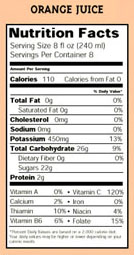Prepared by:
Donna Montgomery, M.S.
Health experts agree that what you eat affects your health
now, and in the future.
|
|
Click here for the printable (Word) version of the lesson
Understanding the Nutrition Facts Label
 Getting Started Getting Started
Before you start this lesson, go to your pantry and pick up a few food products that have
a Nutrition Facts label. If you have two similar products that you can compare,
that would be great. You probably have two different kinds of cereal or maybe two kinds of
soup. You get the idea.As you learn about each point on the label, see if you can find
that information on one of your food products.
What You Will Learn
This lesson will help you to better understand the Nutrition Facts label. You
will learn how to use it to make healthier choices in the supermarket.
Food Guide Pyramid
Review
The Food Guide Pyramid puts dietary guidelines regarding what we need to eat for health
into a visual guide we can follow. This tool guides us in selecting what food to eat and
how much to eat each day to be healthy. We need to eat a variety of food from each of the
food groups.
Introduction
Like many things you do–caring for your family, job responsibilities, preparing meals
and taking care of your home–healthful eating is a balancing act. It takes skill to
get it right.
Health experts agree that what you eat affects your health now, and in the future. It is
important for you to understand the links between diet and health and develop skills to
make informed food decisions.
There are three tools to help you do just that! First, the Dietary Guidelines are
guidelines based on what foods we should eat to maintain our health. Second, the Food
Guide Pyramid puts these guidelines into a visual guide we can follow. This tool guides us
in selecting what food to eat and how much to eat each day to be healthy. We need to eat a
variety of food from each of the food groups. The Nutrition Facts label is the third tool
for healthier eating. Learning to use it will help you make healthier food choices.
History
Nutrition labeling has been around since the 1970s. In the early 1990s, however, the Food
and Drug Administration (FDA) and the United States Department of Agriculture (USDA)
revised the food label in major ways. (USDA regulates labels on meat and poultry, and FDA
regulates labeling on all other food products.) Starting in 1994, food manufacturers were
required to use the Nutrition Facts label on their products.
Label Changes
Nutrition labels are now mandatory for most packaged foods and voluntary for many raw
foods. The nutrition panel has been redesigned to reflect today's health concerns and make
it easer to understand and use. The nutrition panel is called Nutrition Facts.
What's on the Label
The government has set strict definitions for terms that can be used to describe a food's
nutrient content. These are free, low, reduced, high, less, more, light, good source
of, lean and extra lean. On the package you will see words like low-fat, high fiber
and no cholesterol.
Ten health claims are allowed to be used on food labels. They are based on sound research
proving the relationship between a nutrient or food and a disease. These claims are
regulated by the government and give important information about how diet affects health.
Find the ingredient list on your food package. Read the list of ingredients. Ingredient
lists are required on labels of all foods with more than one ingredient. The ingredients
are listed in order by weight, from most to least. If you have food allergies, the
ingredient list can help you identify foods that might be a problem for you.
Food labels tell a lot about a food. They don't suggest what foods to eat. That's your
decision and it should be based on the Food Guide Pyramid. But labels can help you make
the best food choices, choices that benefit you now and in the future, too.
 Issued in furtherance of Cooperative Extension
work, Acts of Congress of May 8 and June 30, 1914, in cooperation with the United States
Department of Agriculture. The Louisiana Cooperative Extension Service provides equal
opportunities in programs and employment. Information and Graphics on this site are
copyright protected by LSU Agricultural Center's Louisiana Issued in furtherance of Cooperative Extension
work, Acts of Congress of May 8 and June 30, 1914, in cooperation with the United States
Department of Agriculture. The Louisiana Cooperative Extension Service provides equal
opportunities in programs and employment. Information and Graphics on this site are
copyright protected by LSU Agricultural Center's Louisiana
Cooperative Extension Services.
For more information on the EFNEP program, contact EFNEPMail@agcenter.lsu.edu. |